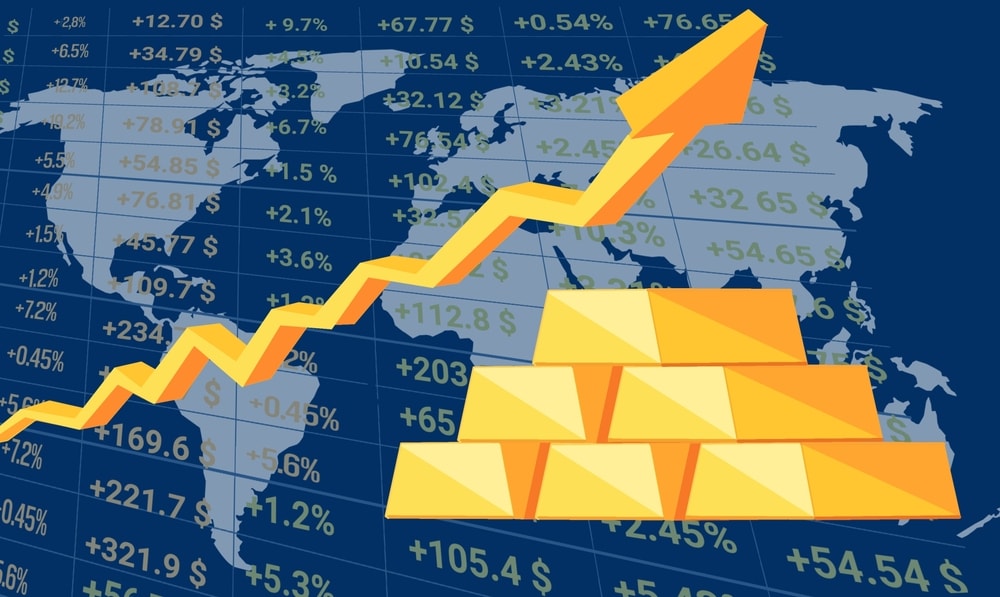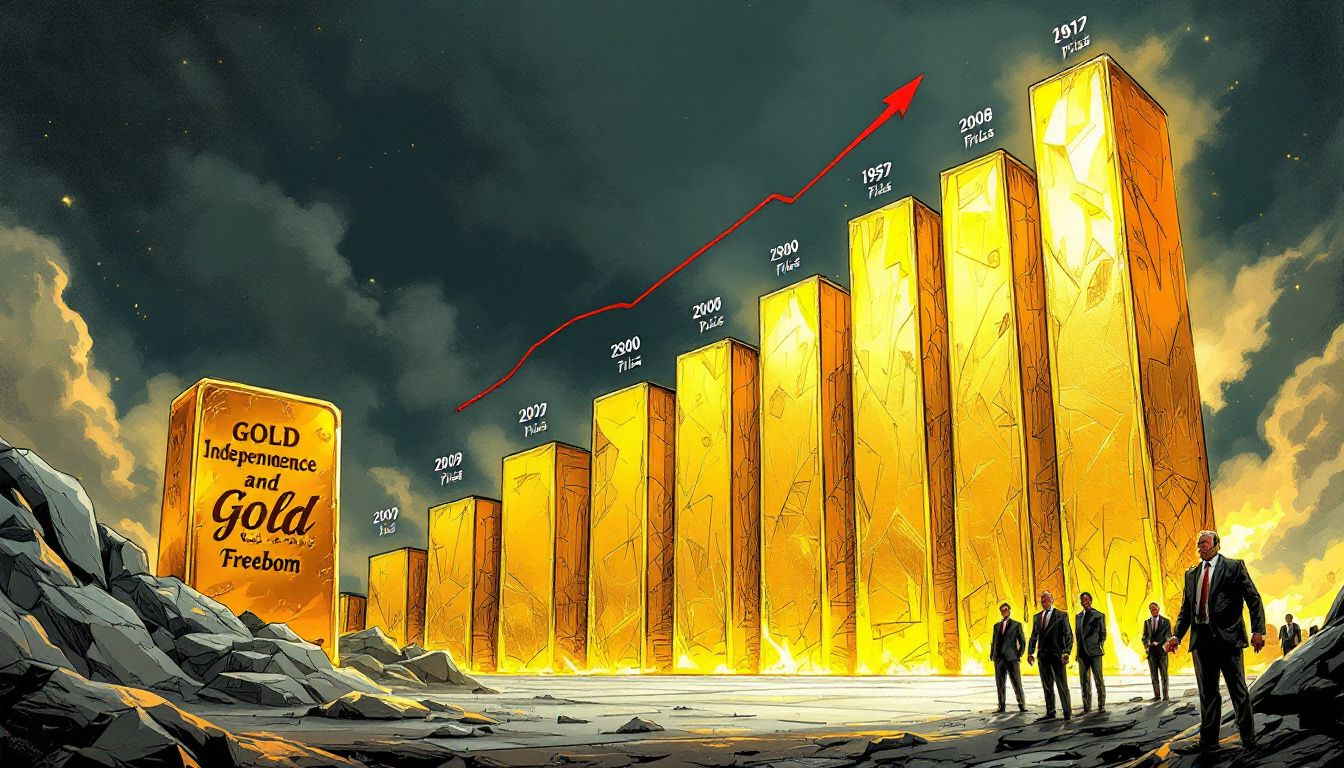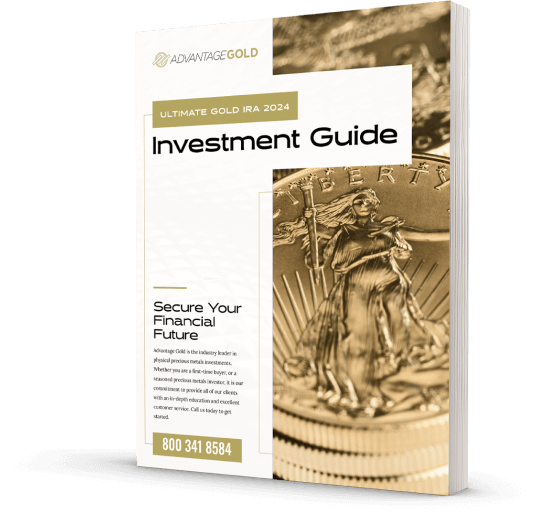
Are gold prices truly independent of the Federal Reserve’s policies? While the Fed’s decisions impact many financial markets, the price of gold often tells a different story. This article explores why gold, historically and presently, does not rely solely on the Fed’s interest rates or policies. You’ll find insights into economic uncertainties, geopolitical tensions, and market demands that drive gold prices, proving its resilience in diverse economic environments.

Gold has long been regarded as a reliable store of value, often rising in value during periods of economic instability. History shows us that gold prices have experienced significant fluctuations, particularly during major economic downturns like the Great Depression and the Great Recession. Between October 2008 and October 2010, the price of gold climbed from about $730 to $1,300 per ounce, even with the Federal Reserve’s low interest rates aimed at stabilizing the economy. This phenomenon highlights that gold prices rallied and are not solely dictated by the Federal Reserve’s monetary policies.
Although the Federal Reserve’s actions can influence financial markets, gold often remains resilient during economic downturns due to factors beyond just interest rates. Even when the Fed tapered its quantitative easing from January 2013 to December 2014, gold prices fell, highlighting the complexity of the gold market and its resistance to being swayed by Fed policies alone.
Gold’s ability to thrive independently of the fed’s monetary policy underscores its enduring appeal as a stable and valuable asset.
Economic uncertainty is a powerful driver of gold prices. During times of instability, investors typically flock to gold, enhancing its appeal as a safe investment. Demand for gold increases during economic uncertainties, as investors view it as a reliable store of value. Unlike other assets that may plummet during market turmoil, gold tends to have a lower correlation with stock market performance, serving as a hedge against volatility.
Market experts highlight that gold’s performance during economic downturns is driven by strong physical demand, particularly from central banks. During economic instability, gold often acts as a hedge against stock market volatility, providing a safe haven for investors seeking to preserve their wealth.
The intrinsic value of gold during uncertain times underscores its independence from the Fed’s monetary policies and its role as a crucial financial asset.
Geopolitical tensions have a profound impact on gold prices. When the world grapples with significant geopolitical conflicts, investors seek safe-haven assets like gold, driving up its value. Escalating geopolitical conflicts often trigger increased gold buying, demonstrating its role as a hedge against uncertainty. Historically, geopolitical crises have led to a rise in gold prices as investors seek stability amidst chaos.
Experts from Kitco Metals Inc. predict that geopolitical tensions will continue to drive gold prices rise higher in the upcoming months. They highlight that geopolitical uncertainties will sustain gold demand, reflecting the metal’s enduring appeal in times of global unrest.
As such, gold’s value is significantly influenced by geopolitical events, further illustrating its independence from the Federal Reserve’s policies.
Asian consumers play a crucial role in the global gold market. Demand from countries like India and China significantly impacts gold prices, independent of U.S. monetary policy. These markets are critical drivers of global gold demand, with their purchasing power often setting the tone for global trends. For instance, major countries such as India and China contribute substantially to the global demand for gold, influencing its price.
Experts anticipate a revival in gold buying from emerging markets, particularly in India and China, highlighting the ongoing significance of Asian consumers in the gold market. This strong demand from Asian markets underscores the fact that gold prices are shaped by a diverse range of factors, not just the policies of the Federal Reserve.

The historical performance of gold prices offers fascinating insights into their resilience and the broad spectrum of influences that affect them. Gold prices often react to global economic conditions rather than solely to Federal Reserve decisions. Gold tends to perform better during phases of declining interest rates, especially when accompanied by economic downturns and falling inflation rates. This trend underscores the diverse factors influencing gold prices beyond the Federal Reserve’s monetary decisions.
Moreover, gold often performs well in low-interest-rate environments, as lower rates diminish the opportunity cost of holding non-yielding assets like gold. Conversely, when interest rates are high, gold prices tend to decline, as investors prefer yield-generating assets. These historical trends highlight the complex interplay of factors that drive gold prices, illustrating their independence from the Federal Reserve’s policies.
Gold has historically reached record highs during economic crises, underscoring its role as a safe haven asset. During the Great Depression, gold prices rose from just under $21 to $35 per ounce, a 67% increase. Similarly, during the 2008 Global Financial Crisis, gold prices surged from around $700 per ounce to over $1,000 per ounce, as investors sought safety amid collapsing financial markets.
More recently, during the COVID-19 recession, gold saw a price increase of 28% from January to August 2020, further emphasizing its value during crises. These instances highlight the unprecedented demand for gold during economic uncertainty, driving prices to record levels and reinforcing its reputation as a reliable asset in turbulent times.
Gold’s performance is notably influenced by different interest rate environments set by the Federal Reserve. Inflationary policies, such as those proposed by Trump, could result in limited rate cuts from the Federal Reserve, thereby impacting gold’s performance. Historically, gold prices react differently to various interest rate environments. In low-interest-rate environments, gold prices often rise as the opportunity cost of holding non-yielding assets like gold diminishes.
Conversely, in high-interest-rate environments, investors may shift their focus to yield-generating assets, leading to a decline in gold prices. This dynamic illustrates how interest rates can influence gold prices, further demonstrating the complex factors that shape the gold market.

Gold prices are influenced by a myriad of factors, including financial instruments, supply and demand dynamics, geopolitical stability, and market trends. These influences extend beyond Federal Reserve policies, highlighting the multifaceted nature of the gold market. High U.S. Treasury yields tend to diminish the attractiveness of gold as an investment, leading to lower gold prices. This interplay between different financial instruments and gold prices underscores the complexity of the gold market.
Additionally, the dynamics of supply and demand for gold can fluctuate significantly based on market conditions and geopolitical events. Understanding these relationships is crucial for investors looking to navigate the gold market effectively.
The relationship between gold prices and Treasury yields is a critical aspect of the gold market. When Treasury yields rise, the attractiveness of gold as an investment often diminishes, leading to lower gold prices. This inverse relationship arises from the opportunity cost of holding non-yielding assets like gold when yield-generating assets become more attractive.
Increased U.S. Treasury yields can diminish the demand for gold, especially in low trading volume periods. This dynamic highlights the sensitivity of gold prices to changes in Treasury yields, illustrating the complex factors influencing the gold market.
Gold’s correlation with the stock market can fluctuate, showing either a positive or negative relationship depending on market conditions. Recently, gold has shown a high positive correlation with U.S. stocks, reaching an r coefficient of +0.945 over one month. This fluctuation reflects the complex interplay between gold prices and stock market performance.
Understanding these correlations is essential for investors aiming to diversify their portfolios and hedge against market volatility. The relationship between gold and stock markets further demonstrates the multifaceted nature of the gold market and its independence from any single influence, including Federal Reserve policies.

Expert opinions provide valuable insights into current gold market trends and future predictions. This year, gold prices have increased by 27%, driven by strong demand from large exchange-traded funds (ETFs) and other investment vehicles. These trends highlight the dynamic nature of the gold market and the various factors that influence its performance.
The insights from leading experts help investors understand the complexities of the gold market and make informed decisions. By examining these expert opinions, we gain a deeper understanding of the factors driving gold prices and the potential future trends.
George Milling-Stanley, the Chief Gold Strategist and one market strategist at State Street Global Advisors, offers valuable insights into gold market dynamics. He believes that gold prices are not solely dictated by the Federal Reserve’s monetary policies, indicating a degree of independence. Milling-Stanley points to economic uncertainty and geopolitical tensions as significant factors that can drive gold prices higher, independent of the Fed.
He forecasts that gold will continue to find support from various global factors and remains bullish on its long-term price trajectory. His views highlight the resilience of gold and its ability to thrive amidst economic and geopolitical challenges.
Experts at Kitco Metals Inc. offer insights into the volatile nature of gold prices and their independence from traditional market influences. Kitco analysts forecast a possibility of gold prices exceeding $3,000 per ounce following recent market trends. These predictions underscore the potential for significant growth in the gold market.
Analyses and forecasts by Kitco Metals Inc. experts highlight the complex factors influencing gold prices and provide valuable guidance for investors navigating the gold market. Their insights emphasize that gold prices are shaped by a diverse range of factors beyond just Federal Reserve policies.

Looking ahead, analysts predict significant volatility in the gold market throughout 2025, despite expectations for higher prices. George Milling-Stanley anticipates that gold prices could range between $2,600 and $3,100 per ounce in 2025, indicating strong market confidence. These predictions reflect the ongoing demand for gold and its role as a hedge against inflation and economic uncertainty.
Beyond 2024, various economic and political factors will continue to shape the gold market. Understanding these factors is crucial for investors aiming to navigate the future of gold prices effectively.
The Federal Reserve is anticipated to reduce rates by 100 basis points by the end of 2025, which could positively affect gold prices. Predictions for 2025 suggest that ongoing economic challenges could lead to a continuation of the current easing trend in monetary policy. Analysts predict that the Federal Reserve may adopt a more accommodative stance, thereby supporting gold price growth.
Experts predict that central bank demand will continue to play a crucial role in driving gold prices, especially from emerging markets. These predictions highlight the potential for significant growth in the gold market, driven by favorable monetary policies and strong demand from central banks.
Trump’s potential second term could lead to improved investor sentiment initially, but may also trigger inflationary pressures affecting gold market dynamics. A second term for Trump may lead to increased tariffs and further protectionist measures, which could elevate gold’s appeal as a hedge against economic instability.
Experts suggest that trade policies, particularly regarding tariffs, could lead to increased volatility in gold markets during Trump’s second term. These potential impacts underscore the importance of political factors in shaping the future of gold prices.
In summary, gold prices are influenced by a diverse range of factors beyond just the Federal Reserve’s monetary policies. Economic uncertainty, geopolitical tensions, and the significant role of Asian consumers all play crucial roles in shaping the gold market. Historical performance and expert opinions further highlight gold’s resilience and independence from Fed policies. As we look towards the future, understanding these complex dynamics is essential for investors navigating the gold market. The insights provided in this blog post offer valuable guidance for making informed investment decisions and anticipating potential trends in gold prices. “`markdown
Economic uncertainties often lead investors to seek safe-haven assets like gold, resulting in increased demand and higher prices. Therefore, during periods of economic instability, gold tends to retain or increase its value.
Geopolitical tensions typically result in heightened demand for gold as a safe-haven asset, causing prices to rise amid global instability. Such dynamics reinforce gold’s role as a critical protective investment during uncertain times.
Asian consumers, especially in India and China, play a crucial role in influencing global gold prices through their strong demand, often affecting market trends beyond U.S. monetary policy. This makes their purchasing behaviors key indicators for future price movements.
Gold has historically performed well during economic crises, often reaching record highs as investors flock to it as a safe-haven asset. This trend confirms its status as a reliable hedge against economic instability.
Gold prices are expected to range between $2,600 and $3,100 per ounce in 2025, influenced by supportive monetary policies and significant central bank demand. This forecast suggests a bullish outlook for gold in the coming years.

Please note that Advantage Gold and its representatives are not licensed or registered investment advisers, attorneys, CPA’s or other financial service professionals. We do not offer or render any legal, tax, accounting, investment advice or professional services. Additionally be aware that precious metals carry risk of loss and are not a suitable investment for everyone. Past performance is not necessarily indicative of future results and you should always consult your financial and tax professional and carefully evaluate all risks associated with the acquisition of precious metals before making the investment.
The statements made on this website are opinions of Advantage Gold LLC. Past performance is not necessarily indicative of future results. Precious metals, Gold American Eagles, Proof Gold American Eagles, certified gold coins, as well as gold and silver bars carry risk and investing in precious metals directly or through an IRA is not suitable for all investors. Precious metals and coins (i.e. Canadian Gold Maples, Canadian Silver Maples, American Gold Eagles, American Silver Eagles, Proof Gold American Eagles, Proof Silver American Eagles, Certified Gold American Eagles, Numismatic Gold Coins) may appreciate, depreciate, or stay the same depending on a variety of factors. Precious metals can and will fluctuate unexpectedly. Advantage Gold cannot guarantee, and makes no representation, that any metals purchased (i.e. .999 gold bars, .9999 silver bars, or any gold coins) will appreciate at all or appreciate sufficiently to produce a profit above and beyond the mark up/ commissions charged whether they are bought for direct delivery or inside of a precious metals IRA. The decision to purchase or sell precious metals with cash or inside of a Gold IRA or a Gold Backed IRA, and which precious metals to purchase or sell, are the customer’s decision alone, and purchases and sales should be made subject to the customer’s own research, prudence and judgment. By accessing any Advantage Gold content, you agree to be bound by the terms of service. Review the terms of service and privacy policy.
*Consult your tax Advisor.